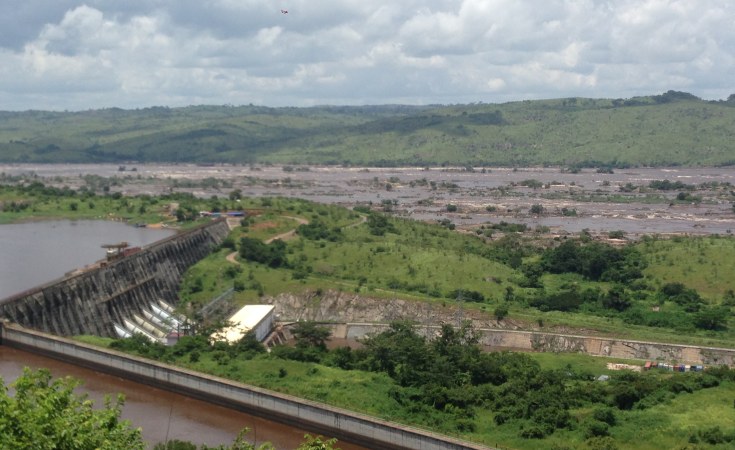The US$80 billion Grand Inga Dam project, including transmission lines to send electricity across Africa and Europe, is touted as having the potential to supply green electricity to the entire sub-Saharan region.
The project has received a fresh boost after Australian mining company Fortescue Metals Group confirmed its alliance with the Democratic Republic of Congo to invest in the development of the world's largest hydroelectric project in Africa.
Previously, in 2013 and 2014, the African Development Bank and the World Bank approved US$141m in grants for the preparation of the project.
The Grand Inga Dam project is a proposed series of seven hydroelectric power stations near the Inga Falls in the Democratic Republic of the Congo. It is an enhancement of the existing 351 MW Inga 1 and 1,424 MW Inga 2 plants completed in 1972 and 1982, respectively.
The dam is to be built in six phases by either of two rival consortiums, one led by China's Three Gorges Corporation which has said electricity could be generated within four to five years. A Spanish engineering giant Actividades de Construction Services (ACS), has suggested Inga 3 would take six years to build.
On completion, that complex is estimated to have an output capacity of 42 GW, generating more electricity than the world's two biggest hydropower plants, Three Gorges on the Yangtze River in China (22.5 GW of generation capacity) and Itaipu in South America (14 GW of generation capacity), combined. This will make it the world's largest power plant.
Displaced people
Inga III is expected to divert water and flood the Bundi Valley for use as a reservoir. This will displace over 35,000 people who may have to move in phase 1 and 25,000 people later, including many who Inga I and Inga II had already displaced.
Bundi Valley is historically home to sacred and ancestral sites, cemeteries and the disruption, loss of livelihood and identity are threatened by Inga III.
Environmental impact
Although the law requires hydropower project developers to do thorough environmental impact assessments, environmental groups have never been satisfied by the safeguards often suggested by hydroelectricity dam developers.
In fact, the head of the Grand Inga Project Office, Bruno Kapandji, suggested that environmental and social impact surveys may not be completed before work starts, thus downplaying the purpose and impact of the assessments.
"It is a choice to make, people have no electricity. We set an objective - we have to produce energy," Kapandji said in an interview with The Guardian. "There are a lot of studies to carry out, at least 18, and we favour some over others based on priority, and to allow us to ... develop a tender document that will be technically and financially acceptable."
Biodiversity issues
It has been argued that the construction of the dam, which was first proposed in the early 1950s, will cause a decline in biodiversity, an increase in waterborne disease and violate national laws and international guidelines on dam construction.
Kapandji added that Inga 3 is the "only solution" to Congo DRC's energy problem and would allow it to export electricity: "As Congolese we have no choice but to build Inga 3. And for the cities in Kinshasa, Bas-Congo and Katanga, Inga 3 is the only solution ... Today the price of commodities is falling and we need revenue. If we have a lot of energy to export, like Canada and Uruguay, we won't have a problem".
Peter Bosshard, California-based NGO International Rivers interim director, intimated that Bruno Kapandji makes it clear that the government does not intend to conduct a social and environmental impact assessment for the huge project before construction starts. "Developing Inga 3 without an EIA will violate national law, World Bank safeguard policies, and Chinese guidelines for overseas contractors."
Power to the people
But even with these issues looming over the project, demand from neighbouring countries is high with South Africa and Angola having already committed to purchasing this energy. The DRC government has already signed a contract with the South African government to supply 2,500MW of electricity from the Inga 3 dam. South Africa's commitment boosted the project's bankability and financial viability.
The rest would be allocated to Congolese households, small businesses and the mining sector, providing electricity to seven million people in the greater Kinshasa area.
But since the power production from the Inga 3 is mainly for industry users, it will not improve the access level for more than 90 per cent of the DRC population with no electricity access.
The prospect of local people getting power from Inga in the next 20 years is remote and does not feature in the project as currently planned. Most of Inga 3's power would travel long distances to the industrial and urban centres in South Africa and large mines in DRC, bypassing Congolese who are not served by the nation's limited grid.
However, an installation such as this would offer a significant contribution to regional developments. Access to reliable, low-cost electricity would bring electricity, industry, and commerce, effectively stimulating the economy and providing access to resources such as health and education.
It could drastically improve the region's quality of life, and demand for electricity will increase dramatically as nations industrialize.
More projects of this scale are likely on the horizon and it is imperative to plan with specific care for the people and ecosystems susceptible to both direct and indirect impacts.


